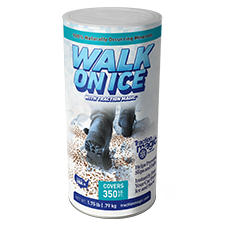Distinguishing Between Concrete Spalling And Scaling

Concrete, as durable as it may seem, is susceptible to various forms of damage over time. Two common problems that afflict concrete surfaces are spalling and scaling. While they may appear similar to the untrained eye, understanding the difference between concrete spalling and scaling is vital for appropriate maintenance and repair.
Ice Melt Concrete Safe: Understanding the Difference Between Spalling and Scaling
Concrete is a durable and versatile material, but it isn’t impervious to environmental and chemical stressors. Issues like spalling and scaling are common forms of deterioration that can compromise the strength and longevity of concrete surfaces. Knowing the difference between these two problems and using solutions like ice melt concrete safe products can prevent further damage. This article explores the causes, effects, and preventative measures for spalling and scaling to help maintain your concrete surfaces.
Difference Between Concrete Spalling and Scaling: Causes, Prevention, and Repair
Concrete structures are renowned for their durability, but they are not immune to deterioration. Two common forms of damage are spalling and scaling, which, though often mistaken for one another, have distinct causes and implications. Understanding the difference between concrete spalling and scaling is essential for addressing and preventing these issues. This guide delves into their causes, preventative measures, and repair techniques to maintain the integrity of your concrete surfaces.
What is Concrete Spalling and Scaling?
Defining Concrete Spalling
Spalling is a phenomenon where chunks or layers of concrete break away from the main surface. This damage is typically caused by freeze-thaw cycles, reinforcement corrosion, or mechanical stresses. Spalling compromises both the aesthetics and structural integrity of concrete.
This condition is often characterized by:
- Large, uneven pits or holes on the surface.
- Visible exposure of the aggregate (the mixture of sand, gravel, or crushed stone) eneath the top layer of the concrete.
- A general deterioration that progresses deeper into the concrete structure over time.
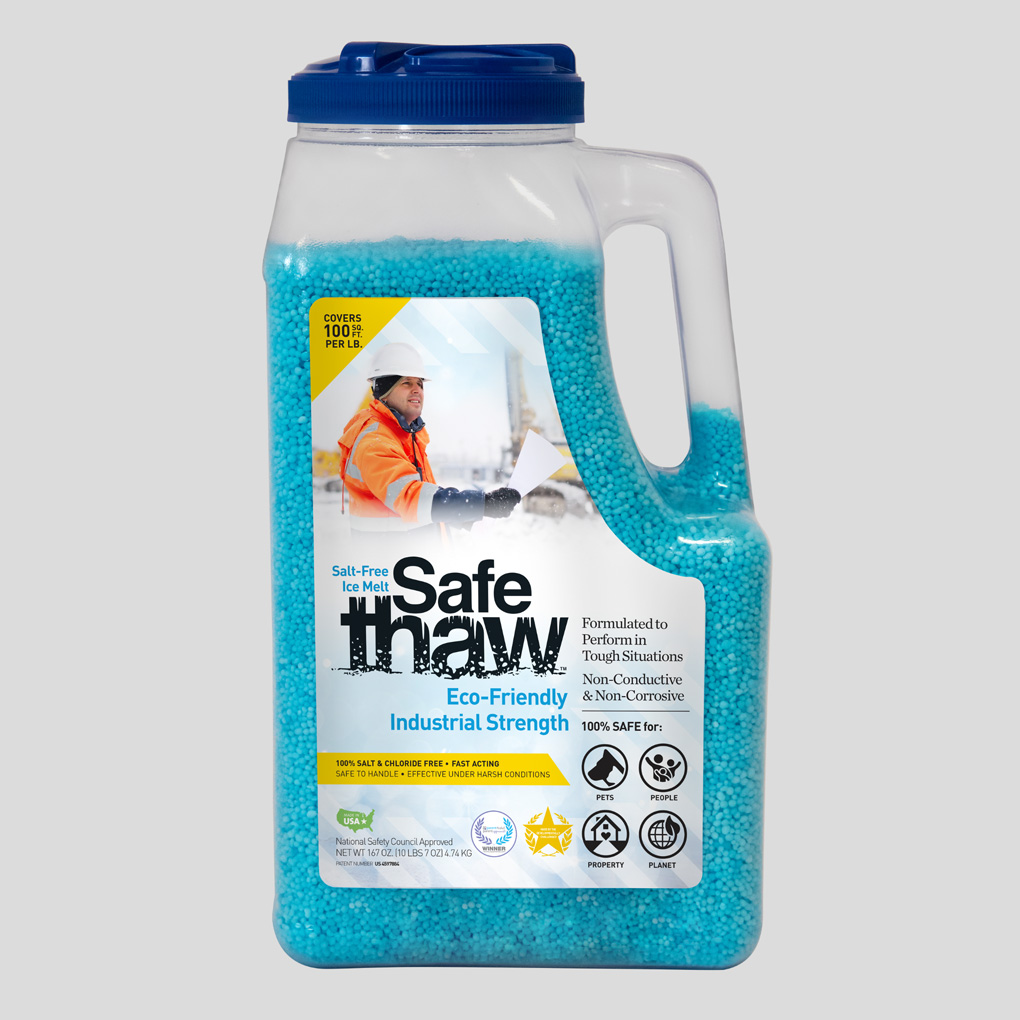
Safe Thaw
Safe Thaw was created as the ice management solution for tough winter environments. Ideal in commercial and industrial properties, shops, government agencies, bridges, and construction.
Causes Of Concrete Spalling
Several Factors Can Lead To Spalling:
- Water infiltration: Concrete is porous. When water penetrates and then freezes, it expands, causing pressure that can force the concrete to flake or spall.
- Corrosion of reinforcing steel: Often, concrete has steel bars or mesh for added strength. If this steel corrodes, it expands and can push out sections of the concrete.
- Improper concrete mix: If the mix used to lay the concrete contains too much water or is cured too quickly, it may be more prone to spalling.
Defining Concrete Scaling
Scaling, on the other hand, refers to the flaking or peeling away of the surface layer of the concrete. This issue is often caused by the use of deicing chemicals and inadequate surface protection, making the concrete vulnerable to freeze-thaw damage. Unlike spalling, scaling primarily affects the surface and is less likely to compromise structural integrity if addressed early.
Characteristics include:
- A generally rough texture on the surface.
- Smaller, more uniform patches compared to spalling.
- Often limited to the surface layer, without exposing the aggregate.
Causes Of Concrete Scaling
Concrete Scaling Often Results From:
- Freeze-thaw cycles: Just as with spalling, water penetration followed by freezing can lead to scaling. However, in scaling, the damage remains mostly on the surface.
- Use of de-icing salts: Herein lies a significant issue. Salts used to melt ice can exacerbate the freeze-thaw damage, leading to accelerated scaling.
- Insufficient curing: If concrete doesn’t cure long enough, it might not achieve the strength required to resist environmental stressors, leading to scaling.
Long-Term Effects of Spalling and Scaling on Structural Integrity
Spalling and scaling can start as surface-level issues, but their long-term effects on concrete can be significant if left unaddressed.
Spalling and Its Consequences
Spalling occurs when large chunks of concrete break away due to freeze-thaw cycles, moisture ingress, or internal pressure caused by reinforcing steel corrosion. Over time, spalling exposes the structural core of the concrete to further damage, potentially reducing load-bearing capacity and safety.
Scaling and Its Implications
Scaling, on the other hand, involves the flaking or peeling of the surface layer, often due to repeated freeze-thaw cycles and the use of deicing products that are not safe for concrete. While scaling is primarily an aesthetic issue initially, it can lead to deeper deterioration if moisture penetrates the surface.
Prolonged scaling and spalling can escalate repair costs and even necessitate complete replacement in severe cases. Protecting your concrete with ice melt that is safe for concrete and regular maintenance helps mitigate these risks.
Preventative Measures Against Spalling and Scaling
Prevention is key to minimizing the risk of spalling and scaling. A few proactive strategies can significantly enhance the lifespan of your concrete surfaces.
Proper Concrete Mix Design
Using a well-designed concrete mix with the right proportions of water, cement, and aggregate reduces porosity and enhances durability. Incorporating air-entraining agents further improves the concrete’s resistance to freeze-thaw cycles.
Adequate Curing Practices
Curing concrete for at least 28 days ensures it achieves optimal strength and durability. Proper curing minimizes shrinkage and reduces the likelihood of cracks that can develop into spalling or scaling.
Application of Protective Sealants
A high-quality sealant forms a barrier against moisture and deicing chemicals, which are major contributors to scaling. Reapplying sealant every two to three years is a simple yet effective way to maintain protection.
Use Eco-Friendly Deicing Products
Avoid traditional deicing salts that exacerbate scaling. Products like ice melt for composite decking are designed to minimize chemical damage while effectively melting ice. These are safer for both concrete and the environment.
Repair Techniques for Spalled and Scaled Concrete
Repairing concrete damage promptly prevents further deterioration and restores its appearance and functionality.
Surface Patching for Spalled Areas
For minor spalling, clean the damaged area thoroughly and apply a patching compound. Use bonding agents to ensure a strong adhesion between the new material and the existing concrete.
Resurfacing for Severe Damage
For extensive spalling or scaling, resurfacing the entire area with the best concrete resurfacer is recommended. Products like Quikrete or Ardex provide durable and aesthetically pleasing results. Ensure the surface is clean and roughened to promote proper bonding.
Addressing Underlying Issues
In cases where spalling is caused by reinforcement corrosion, repair the exposed steel by cleaning and applying a corrosion inhibitor before patching. This prevents further deterioration and prolongs the concrete’s lifespan.
Impact of Environmental Conditions on Concrete Durability
Environmental factors play a significant role in the development of spalling and scaling.
Temperature Fluctuations
Frequent freeze-thaw cycles are a leading cause of concrete deterioration. Water penetrates the concrete, freezes, and expands, creating internal pressures that lead to cracking and flaking.
Moisture Exposure
Prolonged exposure to water weakens concrete and accelerates scaling. Proper drainage systems and sealants are crucial for reducing moisture-related damage.
Deicing Chemicals
Traditional deicing salts (e.g., sodium chloride) exacerbate scaling by increasing water absorption and chemically reacting with the concrete. Using chloride-free deicers like Safe Thaw reduces these risks while ensuring effective ice management.
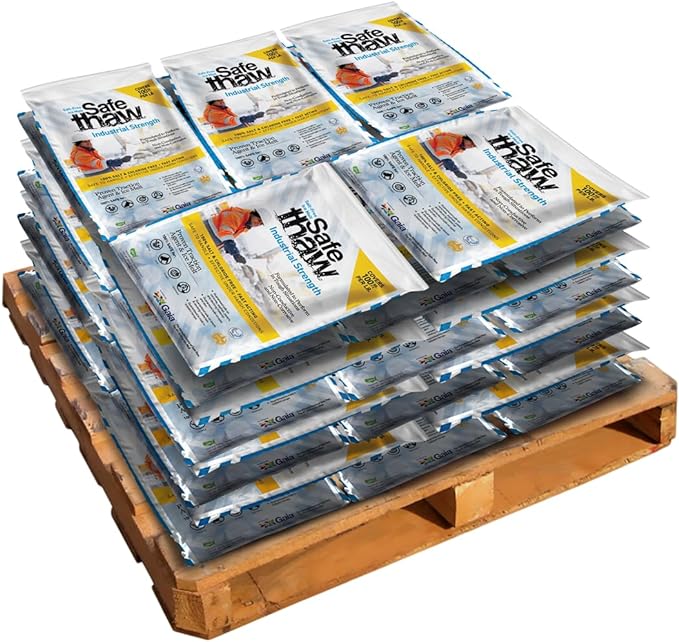
40 Bags
Safe Paw Thaw Industrial Strength Salt-Free Pet Safe Snow Ice Melter and Traction Agent for Concrete, Asphalt, Decks, Lawns, and More, 43 Pound Bag- 40 Bags
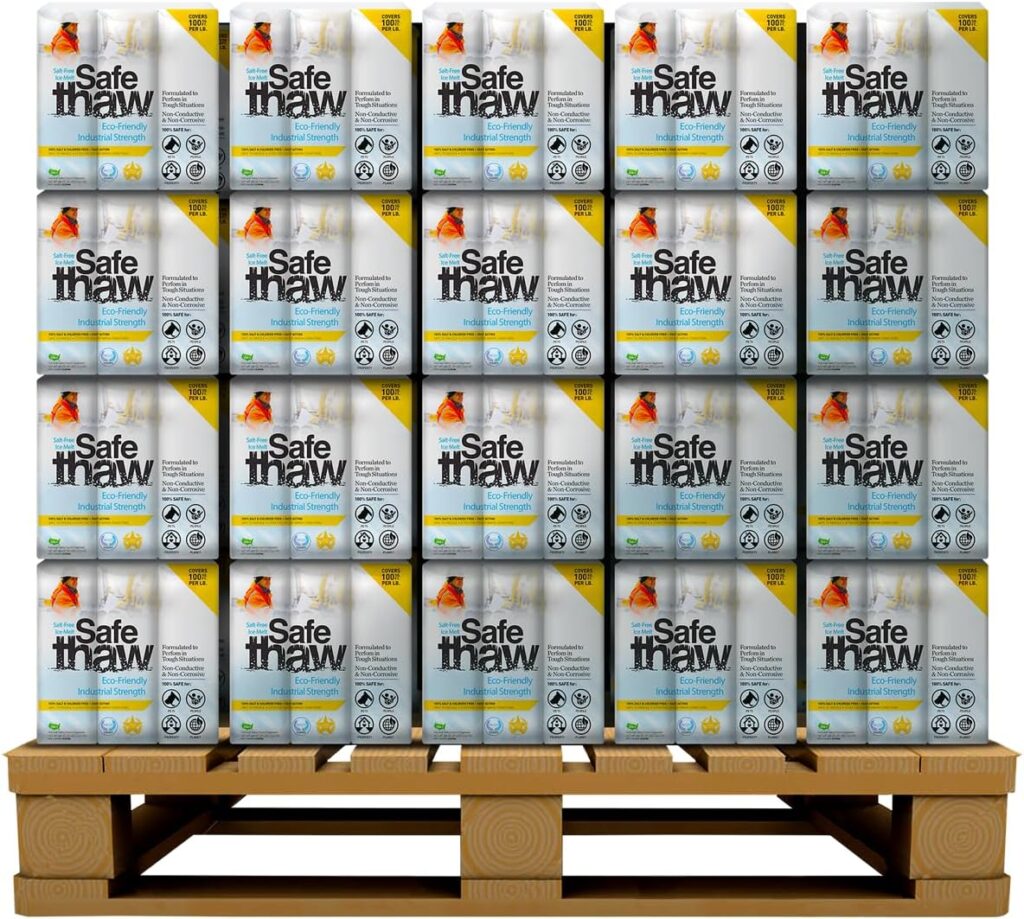
100 Boxes
Safe Thaw Industrial Strength 100% Salt/Chloride-Free, Pet/Paw-Safe Snow & Ice Melter and Traction Agent. Use on Concrete, Asphalt, Roofs & On Any Surface, 30 Pound FlexiPail- 100 Boxes
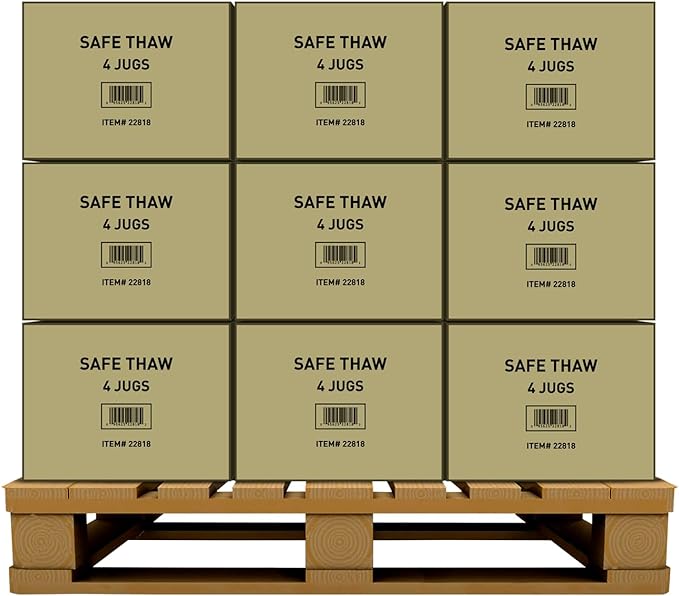
105 Jugs
Safe Thaw Concrete Safe 100% Salt-Free, Pet Safe Snow and ice Melter, Industrial Strength, Chloride-Free, and Traction Agent. Use on Asphalt, Roofs & On Any Surface, 10 Pound Jug- 105 Jugs
Role of Reinforcement Corrosion in Spalling
One of the primary causes of spalling is the corrosion of steel reinforcement within concrete.
How Corrosion Causes Spalling
When steel reinforcement corrodes, it expands, creating internal pressures that cause the surrounding concrete to crack and spall. This issue is common in structures exposed to moisture and chlorides from deicing salts.
Preventing Reinforcement Corrosion
- Epoxy-Coated Rebar: Using epoxy-coated or stainless-steel rebar minimizes corrosion risks.
- Corrosion Inhibitors: Adding inhibitors to the concrete mix protects the steel from chemical reactions.
- Protective Coatings: Applying coatings to the exposed steel during repairs prevents future corrosion and extends the structure’s lifespan.
Choosing the Right Products for Prevention and Repair
Selecting the right materials for prevention and repair is crucial for maintaining concrete durability.
- For Prevention: Use high-quality sealants and eco-friendly deicing agents like ice melt for composite decking to protect surfaces from scaling.
- For Repair: Opt for best concrete resurfacers like SAKRETE or Ardex for reliable and long-lasting results.
Why Using Salt Is Detrimental
While salt is a commonly used solution for melting ice on driveways and sidewalks, its impact on concrete is notably negative. When salt is applied, it lowers the freezing point of water. While this effectively melts ice, the meltwater easily seeps into the porous concrete. As temperatures fluctuate, this water freezes and expands, intensifying the freeze-thaw cycles and accelerating both scaling and spalling.
Moreover, salt can be corrosive, promoting the corrosion of any internal steel reinforcements. This not only weakens the structural integrity of the concrete but can lead to further spalling as the expanding corroded steel pushes against the concrete.
Protecting Your Concrete
Given the damaging effects of salt, it’s essential to find alternatives that are both effective and less harmful. One such solution is Safe Thaw. This granular ice melt is designed to efficiently melt ice without the detrimental impacts associated with traditional salts. Being chemical and toxin-free, Safe Thaw ensures that your concrete surfaces remain in prime condition while reducing the risks associated with spalling and scaling.
Repairing Spalled Surfaces With The Best Products
Now that we’ve established how spalling eats deeper into concrete compared to scaling, the real question is: what are the best concrete spalling repair products available? You can’t just patch the surface with any filler and hope it holds. Spalled areas often expose aggregates or even steel reinforcements, so repair products must bond tightly, resist moisture, and restore durability. Epoxy-based mortars are a common go-to, especially when reinforcement corrosion is at play. They not only fill the damaged space but also provide a protective barrier against further moisture intrusion. For larger areas, polymer-modified overlays work well because they integrate flexibility into the repaired section, reducing the risk of new cracks forming.
Some professionals also recommend resurfacing the entire slab if spalling is widespread. Think of it like giving your driveway or walkway a fresh skin while reinforcing what’s underneath. The real trick is in the prep—removing every loose fragment before applying any product. Otherwise, even the best compound will fail prematurely.
How To Fix Salt Damaged Concrete Without Replacing Entire Sections
You’ve probably seen it: salt applied in winter leaves blotchy, weakened patches that crumble faster each year. So, how to fix salt damaged concrete without tearing it all out? Start with identifying the depth of the damage. If it’s shallow, surface scaling can often be treated with a patching or resurfacing product designed specifically for salt-exposed concrete. If chloride penetration has gone deeper, especially near rebar, the solution is two-fold: clean the steel, treat it with a corrosion inhibitor, and then repair the concrete around it with a high-strength bonding mortar.
An often-overlooked step is sealing once repairs are complete. A penetrating sealer prevents future salt or deicer absorption, reducing the chance of scaling or spalling returning. And this is where prevention ties back to winter maintenance—choosing a chloride-free deicer such as Safe Thaw eliminates the root cause of the damage in the first place. Instead of constantly fixing salt scars year after year, you cut off the cycle altogether.
Addressing Scaling Of Cement Concrete In Harsh Winters
Scaling looks more cosmetic than spalling, but ignoring it can be costly. So scaling of cement concrete needs just as much attention. The common question is, “how to fix concrete scaling effectively without it coming back?” For light scaling, applying a thin overlay using a polymer-modified resurfacer can restore the smooth finish. For moderate scaling, grinding the surface lightly before resurfacing ensures better adhesion. Severe cases may call for thicker overlays or even bonded concrete toppings.
The key lies in preventing further chemical attacks. Most scaling is triggered by repeated freeze-thaw cycles combined with salt exposure. So even after repair, if chloride-based deicers are used, the cycle continues. That’s why surface protection and chloride-free ice management must go hand in hand with repair. Repairing without prevention is like repainting a wall without fixing the leak behind it.
Long-Term Strategies To Prevent Spalling And Scaling Recurrence
Short-term fixes can only go so far. If you’re investing time and resources in repair, it makes sense to adopt long-term strategies to extend the life of your concrete surfaces. For spalling, addressing reinforcement corrosion is non-negotiable. Epoxy-coated or stainless steel rebar, combined with corrosion-inhibiting admixtures, offers future-proofing during new construction. For existing structures, cathodic protection systems can slow down corrosion.
For scaling, regular resealing every 2–3 years acts like sunscreen for concrete, shielding it from water penetration and chemical exposure. Drainage improvements—like redirecting runoff away from driveways or walkways—reduce standing water that accelerates damage. And finally, switching permanently to chloride-free deicers removes the single most aggressive trigger for scaling and spalling in cold climates.
100% salt & chloride-free, fast acting Ice Management Solution
Conclusion
Spalling and scaling may look like surface nuisances at first, but left unchecked, they can lead to structural deterioration and steep repair bills. Knowing the difference between them is only half the story; the other half is acting quickly with the best concrete spalling repair products and surface treatments that address the root cause. Whether you’re wondering how to fix salt damaged concrete or dealing with widespread scaling of cement concrete, the answer lies in combining proper repair techniques with preventative strategies.
Sealants, overlays, and patching compounds restore appearance and strength, but sustainable maintenance practices—like using chloride-free deicers such as Safe Thaw—are what truly break the cycle of damage. With the right repair and prevention measures, your concrete surfaces can withstand the harshest winters without succumbing to the same recurring problems.
Try Also Our Other Winter Safety Products:
Safe Paw
The Original and #1 Selling Pet and Child Safe Ice Melt for over 20 years. Guaranteed environmentally safe –It won’t harm animals or children, and it won’t damage your property. That’s Safe Paw. Safe Paw can change how winter affects our planet.

Walk On Ice
The handy disposable canister can be taken everywhere, with the same 100% naturally occurring minerals that provide instant traction on ice or snow. Use it on sidewalks, steps, or as an instant traction agent for your car.
